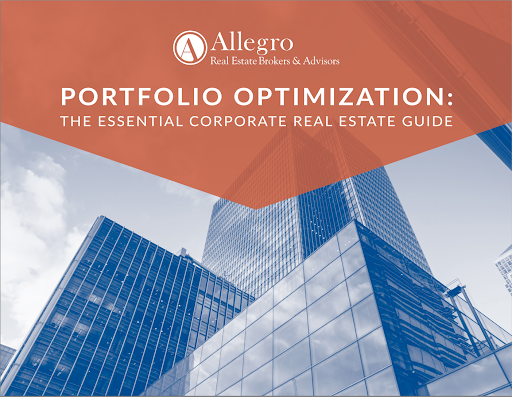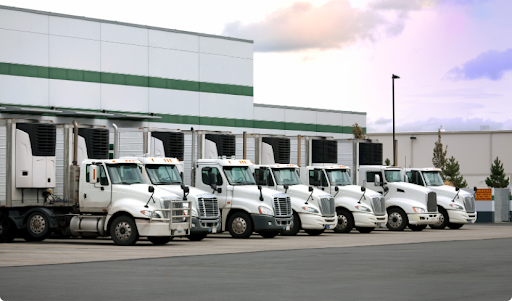Logistics is the complex process of planning and managing how resources are acquired, stored, and transported to consumers.
From a commercial real estate perspective, warehousing and logistics take in all the complex factors involved in the transportation, receiving, and storage of both physical goods and information about them.
Choosing the optimal distribution center locations for a particular organization is critical to managing a modern supply chain efficiently. This is especially true given the production and shipping disruptions caused by the COVID-19 pandemic and the growing demand for next-day delivery in many industries.
Industrial real estate that’s a poor fit in terms of size, location, or equipment can cost a manufacturing or industrial operation higher-than-necessary transportation expenses, the trust of their customers, and future business opportunities.
To simplify the process of choosing the right industrial real estate location and help you achieve your business goals, this guide will cover the following:
- What are logistics properties and who uses them?
- Top trends in logistics real estate.
- Types of logistics real estate and common warehouse features.
- The logistics real estate process.
- The benefits of working with an experienced logistics real estate broker.
What Are Logistics Properties and Who Uses Them?
Many manufacturing and industrial companies employ one or more logistical properties to warehouse their raw materials, or parts and finished goods. Retail companies, with the advent of online shopping, also now rely on logistical properties.
Logistics property refers to a building specifically designed for storage, order picking, and distribution. Some property landlords rent space to multiple tenants, while larger organizations typically have their own facilities adapted to the specific requirements of their products and business processes. Several different types of logistics properties are available today, including distribution warehouses, general warehouses, distribution centers, and specialty warehouses.
Distribution Warehouses and General Warehouses
A distribution warehouse is primarily used to ship goods. These properties are often located near the company’s midpoint and close to transportation facilities so products can be delivered quickly, regardless of the customer’s location.
In contrast, a general warehouse is one used predominantly for storing goods, often for longer periods of time, so location may not be as critical. Truck terminals (sometimes known as transshipment halls or cross-dock warehouses) are intermediate sites where goods are transferred from one truck to another. Given that these sites are focused solely on transportation, they tend to have limited storage space.
Distribution Centers
Distribution centers are structures used primarily for storing goods that are intended for later shipment to retail outlets. They’re not designed for retail sales or for the storage of agricultural products or parts, materials slated to be used in manufacturing, or petroleum products.
Specialty Warehouses
A specialty warehouse is a structure designed to store goods or materials under specific environmental or safety conditions. For example, cold storage warehouses are used to preserve fresh foods, flowers, and other perishables under precise temperature and humidity control.
Potentially hazardous materials such as oxygen tanks or methane cylinders must be warehoused separately, far from flammable liquids or chemicals, in specially designed storage units with strict licensing requirements.
For manufacturers and other industrial companies, finding the appropriate distribution real estate to house these goods and materials is critical to operational and financial success.
While the types of logistics real estate properties remain relatively the same, unprecedented economic factors, like the COVID-19 pandemic, may have a direct impact on businesses’ needs and property availability.
Top Trends in Logistics Real Estate
Rising trends, like the COVID-19 pandemic and the expectation of same-day delivery, continue to disrupt established distribution patterns as manufacturers and other industrial companies have seen massive increases in demand for faster delivery of goods and services.
In turn, companies must expand their logistics infrastructure quickly to allow them to transport inventory where it’s needed rapidly and efficiently. However, as warehouse vacancy rates have dropped, rental rates for what remains have surged. The demand for logistics properties is likely to stay elevated for an extended period.
Many supply chains are looking to boost inventory levels to prevent the stockouts experienced at the beginning of the pandemic. As a result of this demand, new logistics centers are being built in multiple markets, including Cleveland, as companies search for available space. A growing number of manufacturing/industrial companies with logistics real estate needs are turning to commercial real estate services, like those offered by Allegro Real Estate Brokers & Advisors, to choose facilities wisely and negotiate with warehouse rental managers effectively.
The combination of scarce buildable land in densely populated urban/suburban areas, and the growth of e-commerce and multi-channel trade is also forcing logistics infrastructure builders to adapt.
To ensure same- or next-day deliveries to customers, small-scale logistics bases are increasingly being established close to the customers or consumers on the outskirts of urban areas. These bases are necessary for fast and efficient deliveries to “the last mile,” i.e., the short distance that must be spanned to deliver goods to end-user customers.
While the logistics real estate market is ever changing with economic trends, the types of logistics real estate and common property features remain relatively consistent.
Types of Logistics Real Estate and Common Warehouse Features
Companies that rely on strategically located warehouses and distribution centers look for locations close to their manufacturing centers and their customers. Thus, logistics real estate properties tend to fall into one of three major categories: Parks in inner-city locations, large-scale logistics parks, and business parks.
Inner-City Logistics Parks
The growth of e-commerce has required companies to develop shorter delivery routes to achieve faster delivery times than ever before. Thus, logistics properties in inner-city locations are used to deliver goods to customers in “the last mile.”
Courier and parcel service providers often employ small-scale, decentralized properties as inner-city distribution centers. The growth of e-commerce in the food sector presents a particular challenge. Fresh food logistics facilities must meet special technical requirements, such as the availability of cold storage areas. Inner-city parks are also suitable for sales, trading, service, and light manufacturing operations.
Large-Scale Logistics Parks
Large logistics parks near high-density urban centers are often located on greenfield sites that offer ready access to the highway network. Oftentimes these storage areas can be individually adapted to suit its tenant’s needs, and are widely used by trading companies, industry, and logistics service providers.
Business Parks
Business parks fall between small city parks and large logistics parks in size; they are typically located on the edge of a large urban/suburban cluster. Due to their proximity to the city and the range of sizes in which they can be built, logistics properties located in business parks offer a good base for small and medium-sized companies, established companies that need to expand, and local businesses.
When weighing the features of various logistics real estate locations and facilities, manufacturers and industrial companies are most concerned with minimizing the cost and mileage associated with distributing their goods. When it comes to selecting the right logistics real estate, companies tend to look for the following features.
- Clear height. Ceiling heights must be appropriate for the goods to be stored, and allow sufficient rack or shelving space. Too high of a ceiling can increase the cost of real estate, taxes, and utilities, which would inevitably be passed on to the tenant. Too low of a ceiling will reduce storage efficiencies.
- Dock doors. The number, size, and type of dock doors and their proximity to storage areas are key to maintaining efficiency.
- Drive-in doors. These are used often to store vehicles or for loading and unloading within the building.
- Trailer storage and parking space. Adequate space to park trailers at a distance from the warehouse itself is essential if there is a delay in loading or unloading.
- Local laws. It’s important to be aware of any local ordinances that may limit the size or weight of trucks allowed on surface roads, or restrict the type of goods that can be stored.
- Labor costs. The costs for employing both warehouse workers and drivers must be considered, as well as the local availability of qualified workers.
- Bay and column spacing. Spacing issues can have a significant impact on efficiency for warehouse tenants. For example, a speed bay is an area next to the loading areas, ideally measuring at least 60 feet from the dock door to the first column. These bays, which offer only short-term storage, are designed to allow moving goods in a quick and efficient manner.
- Power requirements. Access to chargers with the right amp hr (Ah) rating is essential for recharging the batteries of materials handling equipment like forklifts, etc.
- Fire suppression systems. Depending on the type of goods being warehoused, there are often specific guidelines that must be followed related to sprinkler heads, water pressure, and minimum sprinkler clearance, which can vary widely.
- Proximity and ease of access. The faster drivers can gain access to major highways, rail yards, ports, and airports, the sooner the goods they’re hauling can be on their way.
- Flexibility. The ability to expand to meet changing logistics needs is critical.
Locating and securing logistics real estate that meets the needs of your company can be time-consuming and overwhelming when done alone. That’s why many companies with logistics rely on an experienced real estate broker to guide them through the logistics real estate process.
The Logistics Real Estate Process
Identifying and securing the ideal logistics space can be a costly and confusing process, but it doesn’t have to be. At Allegro, we employ the same tenant representation process for logistics real estate transactions as we do for other commercial real estate transactions. For logistics transactions, the following stages are typically completed over the course of 12 months.
Project Strategy and Criteria Selection
During the project strategy and criteria selection phase, our Allegro project team works closely with you to identify the key success factors and drivers for your logistics real estate search, and to determine critical milestones. In this phase, we also clarify your strategic, financial, and operational objectives and define your facility selection criteria and programmatic requirements.
Market Research and Screening
To develop a short list of viable logistics property alternatives, we conduct comprehensive market research to identify the properties that meet your location and facility parameters, based on many of the building attributes listed above. The next step is to assess budget and programming requirements to eliminate unqualified alternatives, followed by a tour of the viable short-listed properties and a summary of the strengths and limitations of each one.
Decision Support
The decision support stage of the tenant representation process involves gathering the data needed to provide objective analysis to support the decision-making process. This includes developing and managing the distribution of RFPs to warehouse rental management and evaluating their proposed terms.
We also conduct qualitative analyses to evaluate and compare alternatives, as well as perform comprehensive quantitative financial analyses. Once we’ve prioritized the short-list locations, our brokers prepare strategic recommendations for further negotiations.
Leveraged Negotiations
Our team conducts simultaneous, competitive negotiations among the various alternative logistics properties in order to maintain leverage. Now more than ever, maintaining leverage with multiple landlords is one of the best ways to keep rental rates down in an increasingly aggressive market, where landlords have the upper-hand.
Next, we evaluate counteroffers and resolve critical open issues for each property. Working with your company’s attorneys, we finalize key business and legal terms and conditions in negotiations and develop an objective comparison of the strengths and drawbacks of the properties still under consideration. Finally, we deliver a final recommendation and negotiated letter of intent or Memorandum of Agreement for the preferred site(s).
Closing and Documentation
To wrap up the transaction process, Allegro assists your legal counsel in review and preparation of final transaction documentation for the chosen site(s) and provides public relations support for public announcements about the decision. We also deliver the final executed transaction documents, along with a binder of key project correspondence.
Benefits of Working With an Experienced Logistics Real Estate Broker
All commercial real estate brokers are not alike. With our extensive experience working with tenants and logistics companies, the Allegro team can offer advantages that typical CRE brokers cannot match.
1. Independent, Salaried, and Tenant Representation Focus
These core values allow Allegro to provide the best service possible in any transaction, no matter the market. Our independence from global firms and national broker networks gives us the flexibility to select the most appropriate vendors and teams for each of our clients’ unique projects.
As a team of salaried brokers, we attract more than just sales experts to our brokerage; rather, we draw on the strengths of a team of consultants with skills ranging from building labor data to drivetime analysis to support our logistics real estate clients’ decisions. Just as important, we can condense the masses of data we collect for our clients into an easily digestible format.
Finally, a broker who is exclusively tenant-focused can negotiate on your behalf to get the best terms for you. Be cautious of brokers who may just show you properties listed by their company (brokerages double their fees on their own listings). Work with a broker committed to showing you all of the potential spaces based on your priorities, not theirs.
2. In-Depth Familiarity of the Supply Chain
With years of experience in logistics transactions, our team understands the supply chain of manufacturers and other companies with logistics needs, along with the myriad of considerations that go into making these complex real estate decisions.
For example, Allegro recently helped a Fortune 500 food consumer product company to expand its distribution network in Ohio to meet consumer demand. Although their original plan involved just one logistics real estate transaction in Northeast Ohio, the company quickly realized it needed to complete two additional transactions to meet its growth objectives and better serve its customers. Ultimately, we helped the company identify appropriate locations, negotiate deals, and complete all three transactions in less than one year.
3. Equipped With the Right Resources
While most brokers can only provide information on a limited number of markets, Allegro has the relationships and resources necessary to handle logistics real estate transactions anywhere around the country and around the world.
4. Flexible Services for Manufacturers and 3PL Companies
Third-party logistics (3PL) companies can also take advantage of Allegro’s skills in location selection. For many of these companies, their expertise is in inventory management, staffing, setting up warehouse space to house their customers’ products, and providing the transportation services needed.
Relying on Allegro allows 3PLs to focus on these core activities, freeing them of the necessity to search for the optimal locations for facilities in multiple geographies, which they may not have the internal bandwidth or expertise to handle.
In recent years, logistics real estate transactions have been booming. However, finding the right warehousing and logistics centers takes time and energy that most manufacturers don’t have. It is critical now more than ever that companies with logistics real estate needs turn to an experienced logistics real estate advisor to help them expand and ultimately meet the distribution needs of their customers.
Work With a Team of Experienced Logistics Real Estate Brokers
Since 2001, Allegro has been providing clients ranging from startups and nonprofits to Fortune 500 companies and government entities with a broad selection of expert real estate advisory, transactional, and management services.
Today, we bring that same expertise to logistics real estate transactions. To learn more about how we can help you make smarter, faster, more economical decisions when it’s time to expand your logistics real estate network, contact our team to get started.







